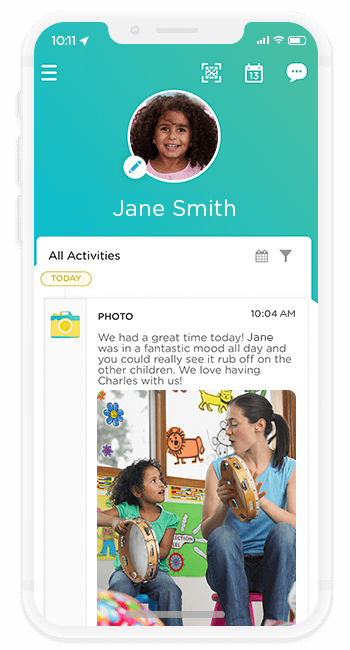
Enrolling kids at a new in-home daycare or center-based care facility always comes with some uncertainty and a period of adjustment for parents. Parents usually work during child care hours and aren’t always used to being away from their children for long periods of time. Job-specific duties and responsibilities can make it difficult or impossible for parents to check in with child care providers during the day.
Even after visiting the facility in person (or completing a virtual orientation), connecting with child care staff and asking plenty of questions, many parents still find it difficult to trust that their children are receiving consistently high-quality care in a healthy environment that supports their development.
When it comes to helping parents alleviate this anxiety, child care centers should aim to create more transparency into their daily operations. Transparency isn’t just about telling the truth (although that’s an important part of it), but also, it’s about making information and updates more accessible to parents so they can feel confident that their child is safe and happy. Transparency in your child care center is a critical factor when it comes to building stronger relationships with parents, gaining their trust and helping them feel comfortable leaving kids in your care.
Let’s take a closer look at the importance of transparency in child care and some communication tactics that your center can use to demonstrate transparency and build stronger relationships with parents.
What is Transparency in Child Care?
For child care centers, transparency means operating in a way that makes it easy for parents to see what you’re doing. It’s about communicating openly and proactively with parents regarding everything related to their child’s wellbeing, and a willingness to be held accountable for the actions you take as a child care provider.
In the past, child care providers maintained transparency by communicating with parents through regular face-to-face interactions and daily reports. Some centers also chose to operate with an open-door policy, where parents were permitted to check in on their child at any time during operating hours.
During the coronavirus pandemic, however, centers are limiting in-person visits and face-to-face interactions to reduce foot traffic within their facilities and decrease the risk of spreading COVID-19. Instead, more centers are using child care management apps to digitally connect with parents and maintain transparency by sending even more timely updates on their child’s daily activities and progress.
In addition to providing regular child care updates and insights, transparency for center-based care facilities also includes being open and honest about pricing (tuition, fees, taxes, etc.), programming, curriculum, activities and lesson plans, and anything else parents need to know about your center.
Let’s take a closer look at why it’s crucial for centers to be forthcoming with this information and keep parents in the loop.
Why is Transparency Important for Your Child Care Center?

Transparent Communication Builds Trust and Loyalty
Over time, transparent communication with parents builds trust and loyalty that leads to customer satisfaction and retention.
When centers communicate proactively about activities, events and schedules, parents see that they’re organized, professional and reliable. When centers send regular updates to parents on their child’s activities and progress, parents get the sense that their child is receiving the individualized attention they need to thrive.
This creates a level of trust between parents, child care providers and the center that makes parents want to remain a part of the child care community.
Transparency Drives Parent Engagement and Child Outcomes
When child care centers can effectively build trust with parents through transparency, they’re laying the groundwork for elevated parent engagement and enhanced child care outcomes. That trusting relationship makes parents more likely to be open and honest about the challenges their kids are facing. In turn, child care providers can leverage their expertise to give valuable feedback and connect families with additional resources in the community.
Transparency Supports Effective Conflict Resolution
As a child care center, being transparent allows you to set expectations with parents and hold them accountable.
Child care billing is a great example here: parents should be aware of your child care enrollment costs, including any late pick-up or early drop-off fees you charge. Your center should clearly communicate about fees during the enrollment process, and you may even wish to have parents digitally sign your fee schedule to indicate they have read it.
This is a great process because you’re showing transparency about pricing and parents are agreeing to be held accountable for payment. Once you’ve shared the correct information, you’ll be able to resolve misunderstandings about billing or child care fees without any surprises.
Transparency Relieves Parental Anxiety
It’s perfectly normal for parents to feel anxious about leaving their kids at a new child care center. Parents worry about whether their kids will feel comfortable and happy, whether they’ll make friends and get along with their peers and teachers, what activities they’ll be doing and even what they’re having for lunch.
Centers can help relieve that anxiety by proactively communicating things like meal schedules and activity plans to parents ahead of time. Parents also love receiving digital daily reports and photos from child care providers.
Five Communication Tactics that Show Transparency in Child Care

Share Images And Video Updates From Your Child Care Center
During coronavirus, most child care centers are limiting foot traffic and preventing parents from entering the building unless absolutely necessary. As a result, parents may feel less comfortable leaving their kids in a space that they can’t see or access.
Centers can increase their transparency here by sharing images and videos with parents from within their child care centers. Procare’s child care app makes it easy for child care providers to engage parents by capturing and sharing their child’s daily experiences and activities.
Adopt Transparent Processes For Billing and Payments
Child care affordability is an important issue for millions of parents, so it’s crucial that child care centers maintain transparency around their billing and payment processes. This allows parents to understand how tuition is calculated, which taxes or fees apply, and how much they should expect to pay for their child’s care.
Procare’s daycare billing software offers attendance-based billing and detailed online reports for centers and parents, giving both parties full transparency into the child care billing process.
Promptly Share New Information – Both Positive And Negative
Parents want to be informed right away if their child gets hurt during playtime, feels unwell or throws a tantrum – not hours later. Some child care providers may be reluctant to make that phone call and cast themselves as the “bearer of bad news,” but most parents would rather receive an immediate phone call or message than wait until later to find out about an incident.
On the other hand, parents shouldn’t just receive updates when something goes wrong – they also want to hear from child care providers when things are going well. When child care providers regularly share positive updates with parents, a relationship is created that makes it easier to report and talk about negative incidents or behavior issues in the future.
To achieve genuine transparency, child care providers must commit to building the relationships that allow them to have difficult conversations with parents when required.
Build Trust With Detailed Daily Reports
Centers can start building trust with parents by producing accurate and transparent digital daily reports. Daily reports can include information like check-in and check-out times, nap times, meal times, diapering, mood updates and more. Parents can log into Procare’s child care app any time during the day to see which activities have been recorded so far. They’ll also receive an automated daily email that summarizes their child’s activities for the day.
Daily activity reports show parents that their child is receiving individualized attention from care providers during the day, a fact that helps alleviate their anxiety and build trust between parents and your center.
Open Two-way Communication And Be Responsive
When it comes to maintaining transparency in child care, opening two-way communication with parents is the final piece of the puzzle. Centers can go beyond proactive information sharing and open communications by:
- Empowering and encouraging parents to contact them with questions and concerns as needed.
- Being responsive to questions from parents and providing prompt responses.
- Being honest and sharing insights to connect families with resources that support their child’s development and wellbeing.
Build Transparency into Your Child Care Center Operations with Procare Solutions

Procare’s child care management software is helping over 30,000 child care businesses streamline and automate administrative processes while delivering a more transparent customer experience.
Procare’s parent engagement capabilities make it easy for child care providers to share schedules, menus and activity plans with parents, along with daily updates that can include images and video. Parents can use our child care app to review tuition payments, see their child’s digital daily report, and reach out to child care providers with questions, comments or concerns about their child’s care.
These features help your center operate with more transparency and build stronger relationships of trust with the parents in your child care community.
Ready to learn more about how Procare Solutions can help you introduce more transparency into your child care operations? Talk to an Expert




